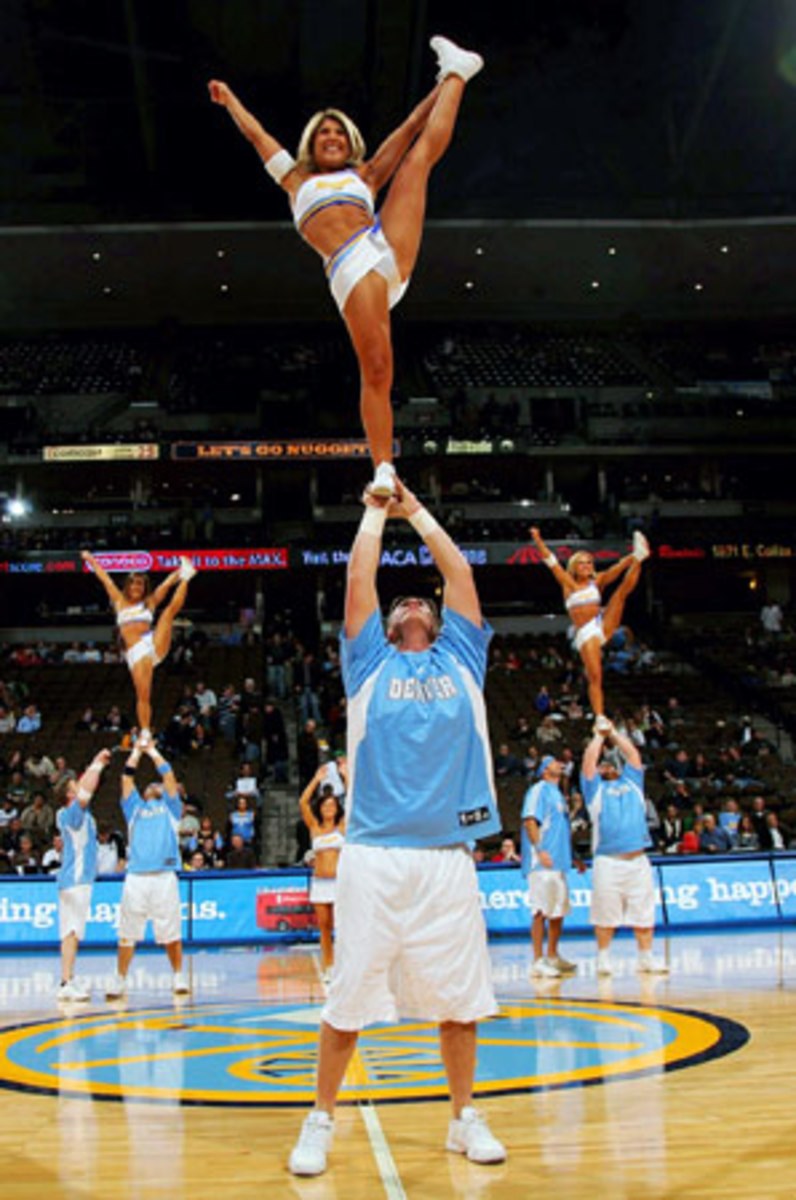
Evolution of cheerleaders
Carpenter, now 28, hadn't thought too much about cheerleading in the two years since he'd graduated college. "But I knew I didn't want to just stare at Excel spreadsheets for the rest of my life," he said. Carpenter dropped by for a practice, and joined the squad. Five years later, he's a captain.
For the past 30 years, college and professional cheerleading have evolved in opposite directions. College teams moved towards competitive cheer, their squad members pulling off intricate tumbling passes; throwing basket tosses, where a girl flies 30 feet in the air; building human pyramids, where a slip can send a dozen people tumbling to the ground; and performing partner stunts, where "flyers" pull acrobatic moves, balancing in the palm of their partner's hands. Professional cheerleaders, on the other hand, followed the Dallas Cowboys Cheerleaders model. Decked out in booty shorts and cropped tops, they shake and shimmy on the sidelines of games, miniature pom-poms in hand.
But lately, more professional sports teams have added stunt squads to their entertainment roster. These teams, made up of male and female cheerleaders, echo the college model with high-flying, gymnastic moves. The Portland Trail Blazers started their stunt squad in 1993. Now, the Nuggets, Los Angeles Clippers, New Jersey Nets, Boston Celtics, Charlotte Bobcats, Houston Rockets and Philadelphia 76ers all have stunt squads. One NFL team -- the Baltimore Ravens -- even has one.
Todd Bosma, director of game operations for the Trail Blazers, said their stunt team debuted alongside their dancers and was spun off into a separate entity. "The League evaluates us and gets feedback from season-ticket holders a few times a year," said Bosma. "The stunt team is one of the highest rated entertainment elements we have. They're extremely popular"
Nuggets entertainment director Shawn Martinez has noticed the same thing. "Every time they do anything high flying, you can hear the oohs and ahhs from the crowd," he said.
Running a stunt team is not cheap. The squads generally have between 20 and 40 members, and the Ravens cheerleaders, for example, are paid $100 per game, plus as much as $90 for community appearances. The average cheerleading uniform costs $200, and most pro squads have multiple crystal-encrusted getups. Add insurance fees to the mix and Grant Harrison, vice president of game operations and promotions for the Utah Jazz, said his stunt team budget comes out to $70,000 a year.
To foot the bill, teams often turn to sponsors. Kia is the benefactor of the Clippers Fan Patrol stunt team, and the Jazz's squad was sponsored by the Dairy Farmers of Utah, who paid a cool $150,000 a year to cover the squad's cost, plus get in-arena advertising on the Jumbotron every time the squad took the floor. But this year, at the last minute, the Dairy Farmers pulled out. "We didn't have time to figure out something else, so we don't have a stunt team this year," Harrison said. "We hope to have them back next year."
Meanwhile, Ravens cheer director Tina Galdieri has seen her stunt squad grow exponentially. A former college cheerleader herself, Galdieri says the growing number of professional stunt squads gives a unique opportunity to cheerleaders who graduate but aren't ready to hang up their pom-poms. "I've had people relocate to Baltimore from Illinois, Texas, Florida, Kentucky," she said. "Cheerleaders are very passionate about their sport, and this is a way to continue. These teams provide a next step."
Stunt squad members range in age from 18 to well into their 30s, and they hold a wide variety of day jobs. Some are lawyers, others teachers and personal trainers. One Ravens' squad member is even an eye doctor.
Performing on a professional team is different from the college experience. "In college, teams get three months to learn a three-minute Nationals routine," said Christopher John, who coaches the Nuggets stunt team along with his wife, Stephanie. "Our team does a halftime show and they learn it the night before. Plus, they have to do it on a hardwood floor in the dark, with strobe lights, fireworks and pyro going off behind them." The Nuggets stunt team has performed at the NBA All-Star game, and done halftime shows with MCHammer, Coolio and the Temptations.
Lauren Spates, 24, who is in her second year with the Ravens' squad, said one of the biggest differences from college is the tryout process, which takes an entire month. "When I graduated, I didn't try out for that following season," she said. "I was miserable. I couldn't wait for March to roll around so I could try out." The tryouts were huge -- there were hundreds of women there, plus cameras from all the news stations in Baltimore and reporters from the Baltimore Sun. I was so thrilled when I saw I'd made it."
Katie Mayfield, 27, cheered for the Ravens for a year and is now on the Clippers' stunt team. "In the NFL, the seats are far from the field. But in the NBA, there are courtside seats, so you get to interact with the fans," she said. "The fans know everything about you -- your name, your job, that your hair is just a little darker than it was last week. You get a proposal every five minutes."
Both Mayfield and Spates agreed that joining a stunt team is a major commitment. In addition to games -- and NBA teams can play as many as four a week -- cheerleaders attend practices and often make appearances at charity, business and community events.
But for Carpenter, the commitment is a no-brainer "We divide the squad so that you're off every third game," he said. "But if I have the night off, I go anyway. I'm just happy to sit courtside at the Nuggets."
Kate Torgovnick is the author of CHEER!: Inside the Secret World of College Cheerleaders.




